Ever wondered why some posts on LinkedIn seem to ignite like wildfire, capturing the attention and engagement of countless users, while others struggle to gain visibility?
The answer lies in understanding the workings of the LinkedIn algorithm.
Beyond mere chance, some specific ranking signals and strategies contribute to the viral success of a post on LinkedIn. While it may seem mysterious at first, a deeper understanding of the LinkedIn algorithm can help you to expand your reach, amplify your brand, and connect with a wider audience.
In this blog, we will delve deeper into the workings of the LinkedIn algorithm, understand why posts go viral, and discover the key elements that drive engagement.
Table Of Contents
- What Is The LinkedIn Algorithm?
- Types Of LinkedIn Algorithms
- 3 Ranking Signals Of The LinkedIn Algorithm
- How The LinkedIn Algorithm Works In 2024
- 10 Hacks To Beat The LinkedIn Algorithm
- Wrapping Up!
- FAQs (Frequently Asked Questions)
You can directly jump to a section of your choice or keep scrolling.
What Is The LinkedIn Algorithm?
The LinkedIn Algorithm is a set of rules used by LinkedIn to determine the visibility, reach, and engagement of content posted by its users.
The topics, niches, and people a user follows decide what posts they will see on their feed. But it's not that simple. The algorithm has been polished over several years to suit the platform's objectives of serving content that aligns with the user's interest. And it goes much deeper than that.
On the one hand, LinkedIn intends to make the user experience more efficient and easier. On the other hand, the platform rules keep becoming stricter and more complex.
Types Of LinkedIn Algorithms
1. Search Algo
LinkedIn Search Algorithm decides the optimal placement of your profile within the vast array of search options. It analyzes the kind of users an individual is currently connected with, what content they are searching for, what content they react to, and what they click on.
Here are the basic ways to optimize your LinkedIn profile to ensure you appear the most on your target audience searches.
- Include your relevant job title. This helps to showcase your experience within similar roles and helps to highlight that you are suitable for a particular role.
- Have a public profile. This indicates transparency and leads to more people coming across your profile, thus making it more searchable.
- Use relevant keywords that attract the relevant audience. For instance, if you are a social media marketer, then 'social media marketing' is not the only keyword to use in your profile. Use more keywords that indicate your field of marketing, your key techniques, etc.

- Use a professional headshot. This gives a great first impression and attracts the right audience. LinkedIn even calls it the 'virtual handshake.'
- Complete your profile. This shows that you are truly a professional and that you have the required qualifications and experience.
- Be consistently active. The more active you are on LinkedIn, the more your searchability increases.
While being consistently active on LinkedIn is essential for increasing your visibility, managing your content can be a time-consuming task. But with Statusbrew's publishing feature, you can plan and schedule your posts in advance to ensure a consistent presence on the platform.
In fact, Statusbrew makes it easy for you to create and schedule content for multiple social networks at once while also customizing posts for each network.
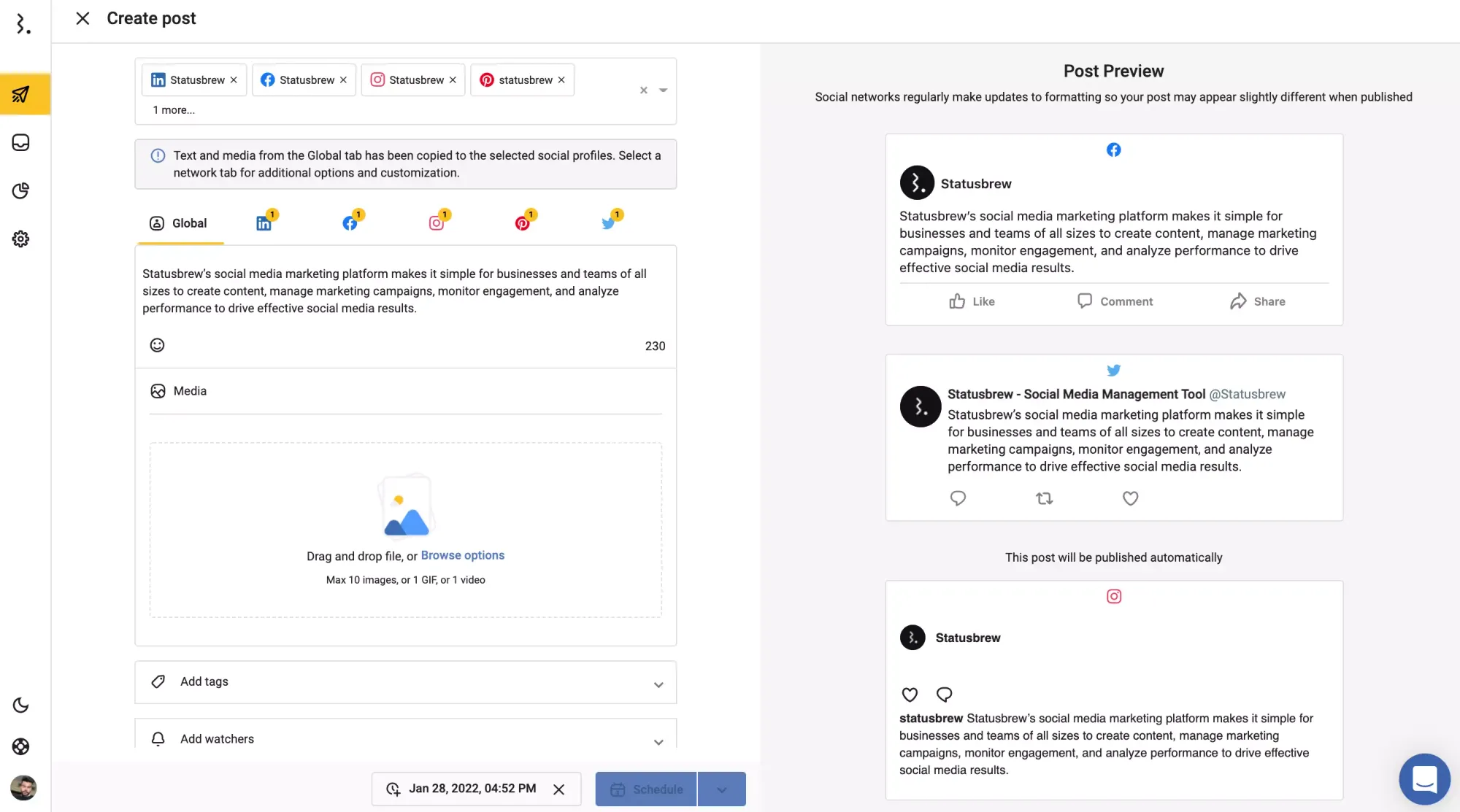
2. LinkedIn Feed Algorithm
LinkedIn Feed Algorithm is a coordinated effort of the LinkedIn moderation team partnered with advanced machine learning technologies. It plays a crucial role in determining the content that appears on users' LinkedIn feeds and ensures that there is only relevant content on the user's feed, not spam or unwanted content.
It works on four key factors:
- Engagement
- Quality
- Relevance
- Frequency
Here's how you can appear more often on both your follower's and unfollowers' feeds:
- Be opinionated. Post content that convinces your audience to start a discussion and drives engagement.
- Engage with other users' content who belong to the same niche. This will help you to become a part of the community.
- Use relevant hashtags that have keywords easily identified by LinkedIn's search.
- Avoid monotony. Use articles, carousels, images, videos, and more on your specified topic to get more engagement.
- Start discussions on specific topics instead of broad areas that are discussed on every other platform.
Take advantage of features such as LinkedIn articles, videos, and documents to diversify your content and provide different formats for your audience to engage with.
3 Ranking Signals Of The LinkedIn Algorithm
The LinkedIn algorithm uses three ranking signals to rank posts in a user's feed. Here's how each of them impacts post-ranking.
1. Personal Connections
In 2019, LinkedIn began deprioritizing content from mega influencers and began highlighting content from users' personal connections. LinkedIn considers these two things to determine a user's connections:
- With whom a user has interacted before on the platform
- With whom a user works or has previously worked
At the top of the feed, users will see posts by people they engage with most often and by those who post consistently. Users will also see posts from connections with whom they share similar skills and interests and skills according to their LinkedIn profiles.
As of 2022, LinkedIn is aiming to introduce more ways to follow creators throughout the feed, including creators, thought leaders, and industry experts that may be outside of a user's network.
2. Interest Relevance
One of the essential ranking signals is relevance. LinkedIn explains on its engineering blog that they already have a strong set of implicit and explicit signals providing context on what content a user may find interesting based on the Knowledge Graph (a company they follow or news widely shared within their company) and their social connections.
LinkedIn also uses an "interest graph" representing the relationships between various topics and users. This allows the LinkedIn algorithm to measure the following:
- How "interested" users are in certain topics
- How "related" are different topics to one another
- Which "connections" share a user's interests
The algorithm also considers the people, hashtags, topics, and companies mentioned in a post to predict interest. You need to understand your target audience and create content that they will find relevant to maximize the interest relevance ranking.
3. Engagement Probability
LinkedIn uses machine learning techniques to rank interaction in two ways:
- How likely a user is to comment, react to, or share a post based on the people and content they have interacted with before
- How quickly a post starts getting engagement after it's published. The faster a post starts receiving engagement, the more likely it is to appear at the top of others' feeds.
Users who interact with others' posts regularly in their feeds are more likely to see engagement on their posts, which in turn means that they will be more likely to show up on other feeds.
How The LinkedIn Algorithm Works In 2024
On LinkedIn, a user's feeds do not show posts in chronological order. Instead, the LinkedIn algorithm determines which posts should appear at the top of a user's feeds. Several factors influence the LinkedIn algorithm. Let's take a closer look at them.
1. Assess & Filter Content By Quality
When you post a piece of content on LinkedIn, the algorithm determines whether it's spam, high-quality, or low-quality content. Spam content is eliminated, high-quality content is cleared, and low-quality content undergoes additional screening.
- Content flagged as spam contains multiple links, have poor grammar, tags more than five people, use hashtags like #follow, #like, and #comment, uses more than ten hashtags, or is one of the multiple posts from the same user within three hours.
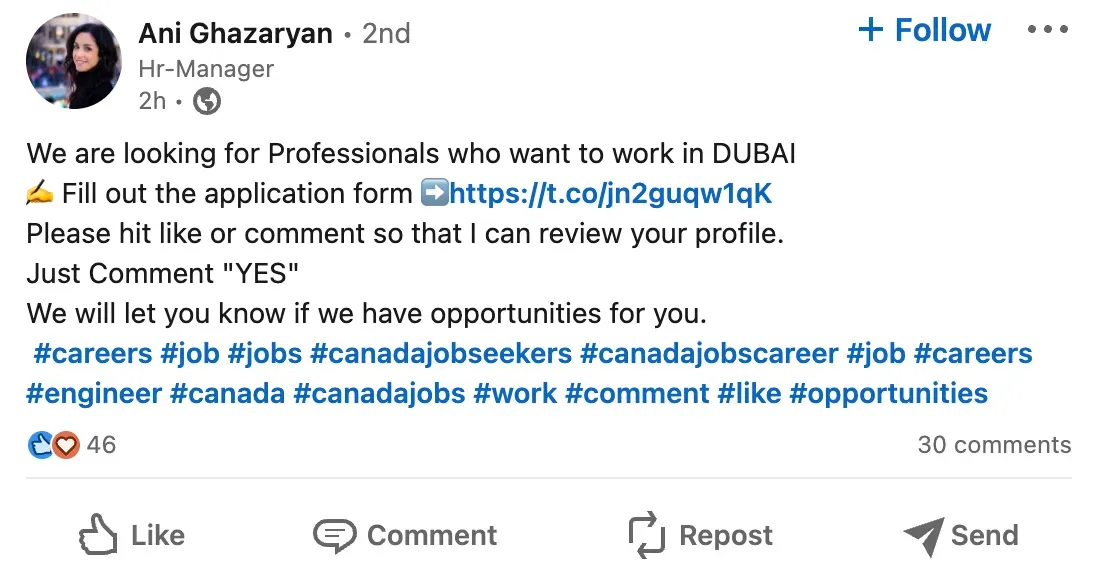
-
Content categorized as low quality is not spam but is considered irrelevant to the audience. These posts are hard to read, deal with topics too broad, and tag people who are unlikely to interact.
-
High-quality content is easy to read, incorporates strong keywords, encourages engagement, reserves outbound links to the comments, and uses three or fewer hashtags. In other words, it is the kind of post your audience will want to read and interact with.
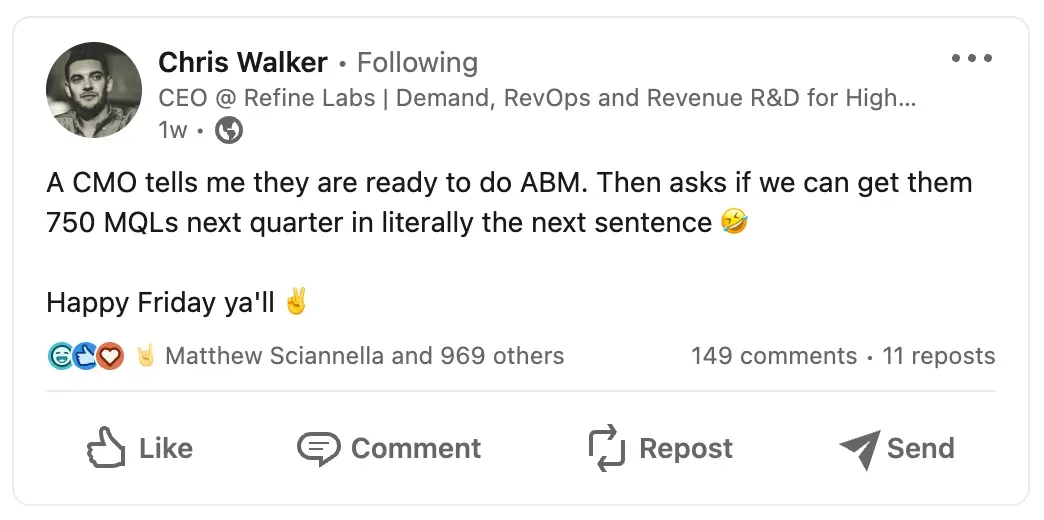
2. Test Post Engagement With A Small Set Of Follower
Once a post has passed the spam filter, the LinkedIn algorithm distributes it to a small set of your followers for a short period of time (about an hour) just to test its ability to generate engagement. If this small group of followers comments, likes, or shares the post within this "golden hour," the algorithm will push it to more people.
On the other hand, if the post is ignored or your followers hide it from their feeds (or mark it as spam), the LinkedIn algorithm will not share it further.
3. Expand The Audience Based On Ranking Signals
If the LinkedIn algorithm decides that your post is worth being sent to a broader set of audience, it will use a series of personal connections, interest relevance, and engagement probability ranking signals to determine exactly who sees it.
4. Continued Engagement Monitoring
Even after your post is pushed to a broader audience, the LinkedIn algorithm will continue monitoring how users perceive it. LinkedIn will stop showing the post to those audiences if your content is entirely ignored by the new audience group or is marked as spam. LinkedIn will keep the post in the rotation if your post resonates with the broader audiences. Posts can stay in circulation for months as long as the post gets a steady stream of engagement.
10 Hacks To Beat The LinkedIn Algorithm
The First Few Hours Matters
The more traction your post gains in the first few hours of posting, the higher the chances are that it will be shown to more people affecting its chances of going viral.
Text Posts Perform Well Too
We have found that plain text posts from founders telling a unique story about their startups are a great way to gain traction as people get an inside look into your startup.
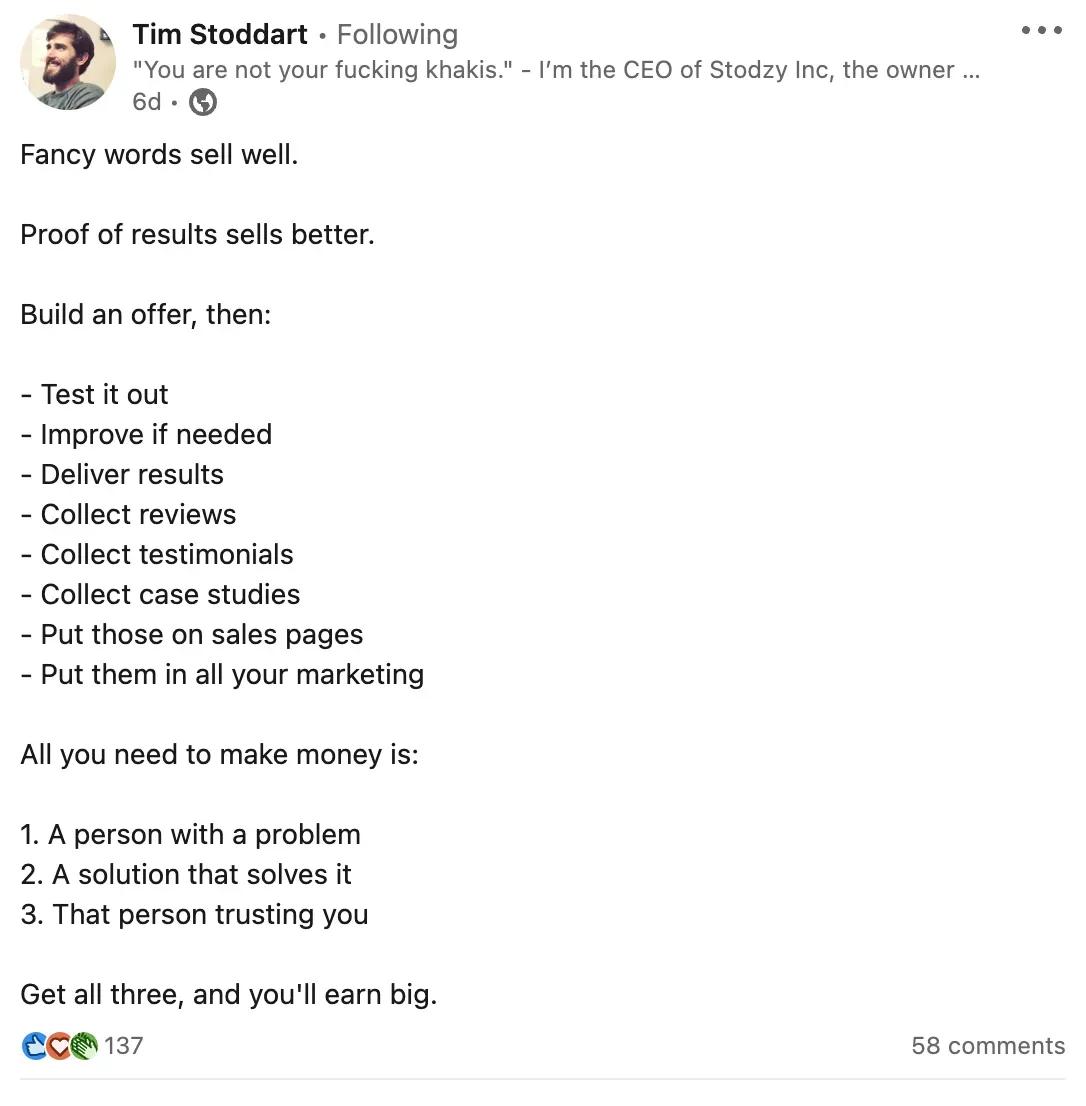
Algorithm Favors Freshness
New posts will perform better than old posts. The more active you are on LinkedIn, the higher the chances are that you will appear in front of your audience more often.
Don't Ignore LinkedIn SEO
Ensure your profile is optimized for LinkedIn SEO.
Check what keywords your competitors are using to appear first on search results. Research, adjust, and adapt accordingly.
Original Content Works
Another algorithm-friendly way to get your post viral is to post original content. You can reuse fresh content by giving it a fresh shell and making it evergreen or by adding a new twist.
Long Vs. Short
The LinkedIn algorithm prefers long posts. A lot of sources concur that long-form posts perform better than their shorter counterparts.
Personalization Affects Engagement
The more you post about things that are relevant to your industry, the more you will resonate with your target audience. The more they will engage with your posts, the more likely the algorithm will push your post in front of your audience.
Quality First
The quality of your content matters. But this doesn't mean that you don't post consistently. Ideally, you should be posting 3 to 5 high-quality posts every week.
Video Works
Video is one of the most engaging types of content you can post. Post videos by optimizing them for the platform videos. Add proper captions featuring subject matter that resonates with your audience and formatted for LinkedIn.
Analytics To Understand Your Audience
Knowing your audience's interests, preferences, and behavior creates targeted and relevant posts that are more likely to capture attention and generate engagement.
With Statusbrew, you can dig deeper into your LinkedIn data and gain insights into your audience's engagement patterns, content performance, and follower growth to better understand your audience's interests and create content that resonates with them.
Wrapping Up!
Understanding how the LinkedIn Algorithm works is essential if you are looking to maximize your presence on the platform. Knowing the key factors influencing the algorithm's behavior, you can optimize your LinkedIn strategy to increase your visibility.
If you are looking to post consistently on your LinkedIn company page, engage with your audience, and monitor your performance, then Statusbrew can help you out. Statusbrew provides the tools and insights you need to elevate your LinkedIn strategy.
Book a free demo today to understand how we can help!
Statusbrew is an all-in-one social media management tool that supports Facebook, Instagram, WhatsApp, Twitter, LinkedIn, YouTube, and even Google My Business.
FAQs (Frequently Asked Questions)
Here are some commonly asked questions on the LinkedIn algorithm:
Does editing a LinkedIn post affect its reach?
Some people have experienced a drop in reach when editing a post immediately after posting it. Hence, it's best to edit a post after an hour of publishing it.
What is the golden hour of LinkedIn?
Golden Hour is approximately an hour after you post on Linkedin. The Linkedin algorithm decides how your post will work depending on how many likes, views, comments, and shares it receives during this hour.
How many hashtags are best for LinkedIn?
LinkedIn recommends using 3 hashtags per post. If you add more than 1p hashtags per post, it can be considered spam by the algorithm.

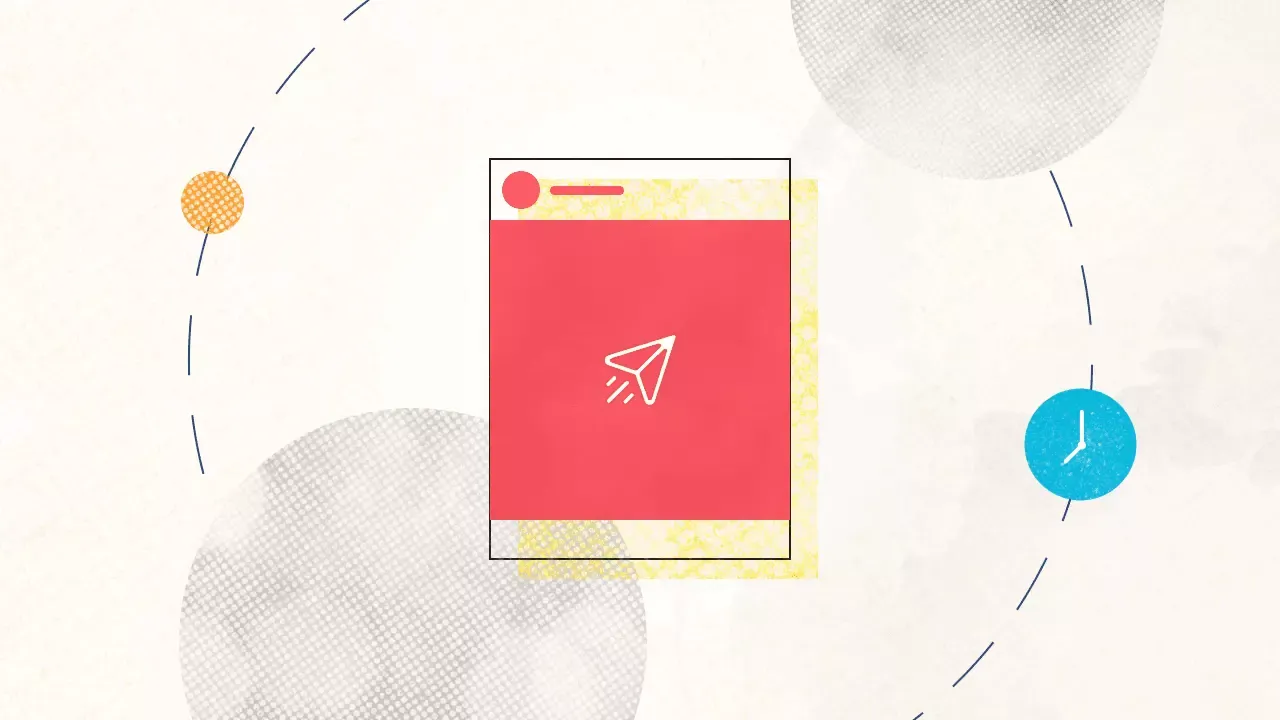


Explore the Statusbrew range of social media tools
Cancel anytime!